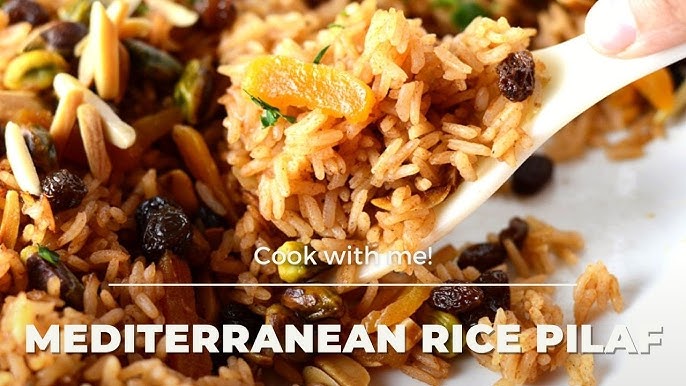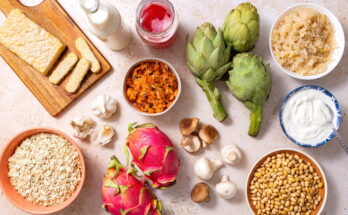Mediterranean Rice Recipe: Mediterranean rice isn’t just a side dish—it’s an experience. With its rich aroma, colorful ingredients, and bold flavor profile, this rice captures the essence of sun-drenched coastal cuisines. What sets it apart? First, the use of herbs like parsley, oregano, and sometimes mint, all of which give it a distinct freshness. Then there are the vibrant vegetables—tomatoes, onions, garlic, and bell peppers—which provide both texture and taste.
Another key element is olive oil. Unlike many rice recipes that rely on butter or ghee, Mediterranean rice leans heavily on high-quality olive oil for that smooth, fruity flavor. Add to that the infusion of spices like cumin, paprika, or turmeric, and you’ve got a dish that tastes like a Mediterranean vacation on a plate.
Let’s not forget that Mediterranean rice is incredibly versatile. It can be served warm or cold, as a side or a main, and it complements both meat and plant-based meals beautifully. Whether you’re hosting a dinner party or meal prepping for the week, this dish is a total crowd-pleaser.
Cultural Influence and Regional Variations
Mediterranean rice is deeply rooted in the traditions of countries bordering the Mediterranean Sea—think Greece, Italy, Spain, Turkey, Lebanon, and Morocco. Each culture has its own version of this beloved staple, often shaped by local ingredients and cooking styles.
In Greece, for example, rice may be combined with lemon juice, dill, and feta. In Lebanon, you’ll find it often paired with vermicelli noodles and pine nuts. Moroccan-style rice might include dried fruits, cinnamon, and nuts, creating a sweeter contrast. Meanwhile, Italian versions lean toward risotto-style with arborio rice, white wine, and Parmesan cheese.
This variety shows just how adaptable Mediterranean rice is. No matter where you are or what ingredients you have, there’s a version that can work for you. It’s a dish with a soul that changes color and flavor with every country, and that’s part of its charm.
Ingredients You’ll Need
Basic Ingredients for Mediterranean Rice
You don’t need a mile-long grocery list to make a great Mediterranean rice dish. Here are the essentials you’ll want to gather:
- Long grain white rice or basmati rice (1 cup)
- Olive oil (2 tablespoons)
- Yellow onion (1, finely chopped)
- Garlic cloves (2, minced)
- Tomato (1 medium, diced)
- Vegetable or chicken broth (2 cups)
- Salt and pepper to taste
- Ground cumin (1 tsp)
- Paprika (1 tsp)
- Fresh parsley (for garnish)
These ingredients form the backbone of a traditional Mediterranean rice. They offer a balanced blend of savory, spicy, and herbal notes that come together to create something memorable.
Each component plays a role—olive oil adds richness, garlic and onion bring depth, tomato adds acidity and brightness, while cumin and paprika introduce warmth and complexity.
Optional Add-Ins and Variations
Want to spice things up a bit? Here are some optional add-ins to elevate your rice:
- Chopped bell peppers (red or yellow for color)
- Sliced olives (Kalamata for that salty, briny punch)
- Chickpeas or lentils (for extra protein)
- Feta cheese (crumbled on top)
- Spinach (stirred in during the last few minutes of cooking)
- Lemon zest or juice (for brightness)
- Pine nuts or slivered almonds (for crunch)
These extras are great if you want to turn this into a full meal or just tailor it to your tastes. Whether you’re going vegan, vegetarian, or adding grilled chicken or shrimp, Mediterranean rice can easily adapt.
Kitchen Tools Required
Essentials for Cooking Perfect Rice
Cooking perfect Mediterranean rice doesn’t require a chef’s kitchen. Here’s a list of tools that’ll make your job easier:
- Medium saucepan with a lid – Essential for cooking the rice evenly.
- Wooden spoon or silicone spatula – For stirring without scratching your pan.
- Sharp knife – To chop those vegetables finely.
- Cutting board – Preferably a non-slip one.
- Measuring cups and spoons – Precision helps when balancing spices.
You don’t need a rice cooker or fancy gear—just a basic stove setup and the willingness to stir a little.
Handy Tips for Preparation
Here are a few tips to make sure your Mediterranean rice turns out just right:
- Rinse the rice before cooking. This removes excess starch and prevents it from getting gummy.
- Use broth instead of water for added flavor.
- Let the rice rest after cooking with the lid on—this allows it to finish steaming and helps achieve that fluffy texture.
- Toast the rice lightly in olive oil before adding the liquid for a nuttier flavor.
- Don’t over-stir once the liquid is added—this can break the grains and make the dish mushy.
Taking a little extra time in the prep stage can make a huge difference in the final dish. Think of this as a labor of love—simple, but rewarding.
Step-by-Step Cooking Instructions
Step 1 – Preparing Your Ingredients
This is where your Mediterranean masterpiece begins. Start by washing the rice under cold water until the water runs clear. This step is non-negotiable if you want fluffy, non-sticky rice.
Next, chop your onions, mince the garlic, and dice the tomato. If you’re adding extras like bell peppers or spinach, prepare those as well. Measure out your spices—cumin, paprika, salt, and pepper—and have your broth ready.
Prep work may seem like a chore, but it’s what makes the cooking part a breeze. Having everything laid out “mise en place” style ensures you won’t be scrambling while the garlic is already sizzling.
Once you’re prepped and ready, it’s time to move to the stove and bring this dish to life.
Step 2 – Sautéing Aromatics and Spices
Now that you’ve got all your ingredients prepped, it’s time to build that flavor foundation. Start by heating two tablespoons of olive oil in your saucepan over medium heat. Once it shimmers, toss in your chopped onions. Sauté them for about 5-6 minutes, stirring occasionally, until they turn translucent and soft.
Next, add your minced garlic and give it a quick stir—about 30 seconds should do. You’ll know it’s ready when that unmistakable garlicky aroma fills the air. Be careful not to let it brown, or it may turn bitter.
Now comes the fun part—spices! Sprinkle in your cumin and paprika, and stir for another minute to let the spices bloom. This little step intensifies their flavor and infuses the oil, which in turn coats every grain of rice you add later.
Throw in your diced tomatoes next. Let them cook for about 3-4 minutes, just enough to soften and begin releasing their juices. This mixture becomes the heart of your Mediterranean rice, deeply aromatic and layered with flavor.
Optional twist: If you’re using bell peppers, olives, or other add-ins, now’s a good time to add them in. Let them cook along with the tomatoes for added depth.
By now, your kitchen should smell like a Mediterranean street market—and that’s exactly what we’re going for.
Step 3 – Cooking the Rice to Perfection
Here’s where the magic really starts to happen. Add your rinsed and drained rice to the pot. Stir it gently to combine with the onion-tomato-spice mixture. Let it toast for a couple of minutes—this small step adds a subtle nutty flavor and helps the rice maintain its structure as it cooks.
Now, slowly pour in your broth—vegetable or chicken, depending on your preference. Bring the mixture to a gentle boil, then reduce the heat to low and cover the pot with a tight-fitting lid.
Let it simmer gently for 15-20 minutes. No peeking! Lifting the lid lets steam escape, and steam is exactly what cooks the rice evenly. Trust the process and keep that lid on.
Once the time is up, turn off the heat but don’t lift the lid yet. Let it sit covered for another 5-10 minutes. This resting time allows the rice to steam to perfection, ensuring every grain is light, fluffy, and full of flavor.
When you finally lift that lid—voilà!—you’re greeted with a beautifully aromatic, vibrant rice dish that’s ready to steal the show.
Step 4 – Final Touches and Garnishing
With the rice cooked and rested, it’s time for the finishing touches that elevate your dish from good to unforgettable.
First, fluff the rice gently with a fork to separate the grains. This prevents it from turning mushy and keeps that light, airy texture we’re after.
Next, stir in freshly chopped parsley. This adds a pop of color and a refreshing herbal finish that balances the warm spices. If you like a bit of zing, squeeze a little fresh lemon juice over the top—it brightens up the entire dish.
Now’s your chance to get creative with garnishes. Here are a few ideas to make it pop:
- Crumbled feta cheese for a creamy, salty touch
- Toasted pine nuts or almonds for a nutty crunch
- Sliced green onions or chives for an extra layer of freshness
- A drizzle of extra virgin olive oil to enhance richness
Presentation matters, especially if you’re serving this for guests. Consider plating it in a shallow bowl or serving platter with a few lemon wedges on the side. The colors and aromas alone are enough to get everyone excited.
And just like that, your Mediterranean rice is ready to serve—golden, fragrant, and absolutely irresistible.
Serving Suggestions and Pairings
Best Dishes to Serve with Mediterranean Rice
Mediterranean rice is wonderfully versatile, making it the perfect companion to a variety of mains. Here are some top-tier pairings to try:
- Grilled chicken or lamb kebabs – The smoky char complements the spices in the rice.
- Baked falafel – For a vegetarian option, this combo is hearty and protein-rich.
- Stuffed bell peppers – Use the rice as a filling with extra herbs and cheese.
- Roasted vegetables – Eggplant, zucchini, and bell peppers make a deliciously earthy side.
- Shakshuka – Serve the rice underneath poached eggs and tomato sauce for a brunch twist.
No matter what you pair it with, Mediterranean rice has a way of holding its own while enhancing the meal.
Ideal Occasions for This Recipe
This isn’t just a weekday dinner solution—Mediterranean rice is special enough for a range of occasions:
- Family gatherings – It’s a dish everyone can enjoy, from kids to grandparents.
- Potlucks and parties – Easy to transport and always a hit.
- Meal prep – Make a big batch and store it in the fridge for quick lunches.
- Picnics or beach days – Delicious even when served cold.
- Date nights at home – Light some candles, pour a glass of wine, and enjoy.
Its flexibility, flavor, and beauty make it the kind of dish you’ll come back to again and again, no matter the occasion.
Health Benefits of Mediterranean Rice
Nutritional Profile
One of the standout features of Mediterranean rice is its nutritional value. Packed with whole foods and healthy fats, this dish is a great example of how delicious can also mean nutritious. When made with ingredients like olive oil, fresh vegetables, and lean proteins, Mediterranean rice fits well within a heart-healthy, balanced diet.
Here’s a general nutritional breakdown per serving (without add-ins like cheese or meat):
- Calories: Around 200-250
- Protein: 4-6 grams
- Fat: 8-10 grams (mostly from olive oil)
- Carbohydrates: 35-40 grams
- Fiber: 2-4 grams
The olive oil provides monounsaturated fats, which are known to support heart health and lower bad cholesterol. Garlic and onions offer anti-inflammatory and immune-boosting properties. When you toss in extras like spinach, tomatoes, or legumes, you boost fiber and vitamin content even more.
Mediterranean rice also supports long-term health goals. It’s low in processed ingredients and sugars, making it suitable for people managing blood sugar levels. Plus, the dish can be easily adapted for gluten-free, vegetarian, and vegan diets.
Dietary Adaptations
The great thing about Mediterranean rice is how effortlessly it can fit various dietary needs. Here’s how to tweak it for specific lifestyles:
- Vegan: Stick to vegetable broth and skip cheese or use a plant-based alternative.
- Gluten-Free: Naturally gluten-free as long as your broth and spices are certified GF.
- Low-Sodium: Use low-sodium broth and go easy on the added salt. Rely more on herbs and lemon juice for flavor.
- High-Protein: Add chickpeas, lentils, or grilled chicken for an extra protein punch.
If you’re following the Mediterranean Diet (one of the most recommended eating patterns globally), this rice recipe aligns beautifully with its principles—fresh produce, healthy fats, and whole grains.
Common Mistakes to Avoid
Overcooking or Undercooking the Rice
Rice is deceptively simple. One misstep in cooking can turn fluffy grains into a mushy mess—or worse, a crunchy disaster. The most common mistake is either overcooking or undercooking the rice. Always follow the proper water-to-rice ratio (usually 2:1) and keep the heat low once it starts to simmer.
Don’t forget the resting period after the cooking time ends. That final 5-10 minutes of steam time, with the heat off and the lid on, makes a massive difference in texture.
Neglecting to Rinse the Rice
Skipping the rinse step? That’s a rookie move. Rinsing rice removes surface starch that causes it to clump and become gummy. It’s the secret behind fluffy, separated grains—the hallmark of good Mediterranean rice.
Simply place the rice in a fine mesh sieve and rinse it under cold running water until the water runs clear. It takes a minute but makes all the difference.
Using Too Much or Too Little Oil
Olive oil is a star ingredient, but balance is key. Too much, and your dish becomes greasy. Too little, and it lacks richness and depth. Two tablespoons per cup of rice is the sweet spot, giving you flavor without overdoing it.
Skipping the Spices
This dish relies on spice—not heat, but flavor. Cumin and paprika are essential, but if you skip or skimp on them, the rice turns bland. Toasting the spices in olive oil before adding the rice makes them bloom and enhances the dish tenfold.
Storing and Reheating Tips
How to Store Mediterranean Rice
Have leftovers? Great! Mediterranean rice stores beautifully and often tastes even better the next day as the flavors meld together.
- Refrigerator: Store in an airtight container for up to 4 days.
- Freezer: Portion into freezer-safe bags or containers. Label and date. Keeps well for up to 2 months.
Just make sure the rice cools down before storing to prevent moisture buildup and spoilage.
Best Reheating Methods
Reheating rice can be tricky if you want to keep that perfect texture. Here’s how to do it right:
- Microwave: Add a splash of water or broth, cover loosely with a microwave-safe lid or plate, and heat in 30-second intervals until warm.
- Stovetop: Place the rice in a skillet with a tablespoon of water or broth. Cover and heat over medium-low until hot.
- Oven: If reheating a large batch, place in a baking dish, cover with foil, and bake at 300°F (150°C) for about 15-20 minutes.
Avoid overheating, as it can make the rice dry or rubbery.
FAQs about Mediterranean Rice Recipe
1. Can I make Mediterranean rice in a rice cooker?
Yes! Sauté your aromatics separately, then combine everything in the rice cooker and let it do the work. The result is still fluffy and flavorful.
2. What type of rice is best for this recipe?
Long grain white rice or basmati rice are ideal. They stay fluffy and don’t clump together, making them perfect for Mediterranean-style dishes.
3. Is Mediterranean rice gluten-free?
Absolutely. Just make sure your broth and any add-ins are certified gluten-free.
4. How can I make this dish spicier?
Add a pinch of cayenne pepper or some red chili flakes while sautéing the spices. You can also stir in a chopped chili for extra heat.
5. Can I serve this dish cold?
Yes, Mediterranean rice works beautifully as a cold salad. Add cucumbers, cherry tomatoes, and a lemony vinaigrette for a refreshing twist.
Conclusion
Mediterranean rice is more than a side dish—it’s a celebration of flavor, health, and culture in every bite. Simple yet elegant, it’s a recipe that you can whip up on a busy weeknight or showcase at your next gathering. Whether you keep it classic or customize it with bold add-ins, this dish delivers every time.
From its humble ingredients to its rich, aromatic taste, Mediterranean rice is a true gem. It invites experimentation, supports healthy living, and satisfies cravings like few other dishes can. So grab your ingredients, fire up the stove, and get ready to impress your taste buds.



